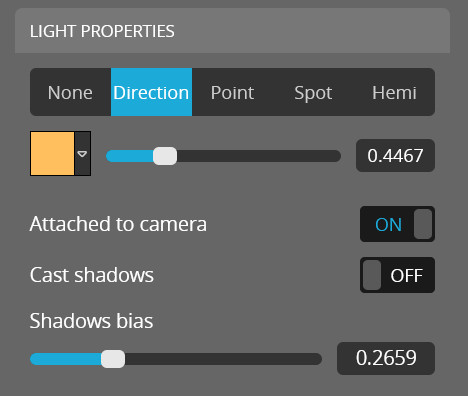Appearance
Lights
Any scene can have up to three lights. The API enables you to manipulate these lights, such as turning them on and off, changing the color, enabling shadows and more. It's also possible to move and rotate lights, but we will cover that in later tutorials. It requires matrix math that is beyond the scope of this tutorial.
Getting lights
The first step is to get the lights from the viewer. This is done with the getLight method. It returns the settings of a single light. We can also use the isLightFeatureEnabled to find out if the lights feature is enabled in the scene.
The getLight method takes an id as the first argument. There's one id for each light in the scene: 0, 1 or 2.
js
api.getLight(0, function (err, state) {
window.console.log(state);
});This example scene contains three different lights: a spotlight, a directional light and a point light. One thing that stands out when you get the properties of each of these ligths, is that they all return the same number of properties (with different values). This list of properties does not match the properties that are available in the editor. You get some extra properties for certain lights and other properties are not available in the API. We have to make do 🤨
Spot light
This is the data of the spotlight. I've removed the matrix data for now. All of these properties are used by the spotlight. We're missing the Shadows bias and Softness properties.
js
{
"type": "SPOT",
"attached": true,
"matrix": {...},
"enabled": true,
"shadowEnabled": true,
"color": [0.42, 0.6, 0.49],
"intensity": 0.87,
"angle": 19.2,
"falloff": 0.00007782915127005909
}And these are the settings from the editor:

Directional light
This is the data of the directional light. I've removed the matrix data for now. Only the highlighted lines are used by the directional light. We're missing the Shadows bias property.
js
{
"type": "DIRECTION",
"attached": true,
"matrix": {...},
"enabled": true,
"shadowEnabled": false,
"color": [0, 0.76, 0.35],
"intensity": 0.44,
"angle": 45,
"falloff": 0.00008901450994447913
}And these are the settings from the editor:

Point light
Finally, the data of the point light. Th epoint light uses the least of these properties. We're not missing any properties.
js
{
"type": "POINT",
"attached": false,
"matrix": {...},
"enabled": true,
"shadowEnabled": false,
"color": [0.99, 0, 0.43],
"intensity": 1.9,
"angle": 45,
"falloff": 0.003413014998977679
}And the settings from the editor:

Setting lights
Let's try to manipulate the lights. We can use the setLight method to change the properties of a light. It takes three arguments: the id of the light, the properties to change and a callback function.
js
api.setLight(2, { color: [1, 0, 0] }, function (err) {
window.console.log("Set light");
});Spot light
This example sets the color of light 1 to red. The color is normalized in the 0-1 range. Take a look here for more details about dealing with colors in Sketchfab.
The next example shows how to manipulate some of the settings of the spotlight. Please note that the falloff value is ridiculously tiny, but it does work. The softness property is not available in the API, nor is the Shadows bias property.
Directional light
This example sets the shadowEnabled and attached of light 0. You'll notice that setting the attached does not work even though it's available in the API. This setting seems to be broken. The shadowEnabled property does work.
Point light
This final example adjusts the color, falloff and type of the light. The three types that I'm using here are POINT, SPOT and DIRECTION.
Toggle all lights
Each individual light has an enabled property. You can toggle all lights at once with the setLightFeatureEnabled method.
js
api.setLightFeatureEnabled(true, function (err) {
window.console.log("Lights ready to be used");
});Documentation
Lighting API documentation